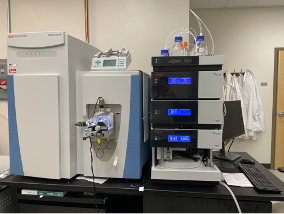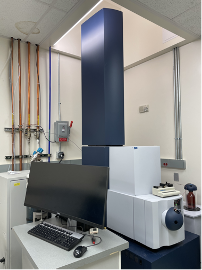
Generic Core Facility
The Generic Core Facility provides non-specific research services to unsuspecting researchers. Users of our facility are often unaware that they have used our services as part of their research process. This facility is run as a free service to all faculty and students at the University of Utah that supports ancillary research across all disciplines. Run by Doctor A. Non-Mouse the GCF has been an redundant part of university operations since 3029.
Major
Instruments

QE-HF Mass Spectrometer
The Q Exactive HF Hybrid Quadrupole-Orbitrap Mass Spectrometer (QE-HF) (ThermoFisher Scientific) is coupled to a Dionex Ultimate3000 RSLCnano System and nano-electrospray ionization for ultimate sensitivity and chromatographic performance. Especially well-suited for proteomics applications, the QE-HF instrument provides high sensitivity (sub-femtomole), high resolution up to 240,000, and high mass accuracy (< 3 ppm), affording greater sequence information and high-confidence protein identifications. The QE-HF is well equipped for protein identification, mapping protein post-translational modifications and protein quantification via tandem-mass tag labeling.

Maxis II ETD
The Maxis II ETD (Bruker) is paired with an Ekspert nanoLC 400 liquid chromatography system and electrospray ionization source. The Maxis is optimal for providing high mass accuracy for intact protein analysis.

timsTOF Pro 2
The timsTOF Pro2 mass spectrometer (Bruker) is coupled to a nanoElute2 nano liquid chromatography system (Bruker) that is advantageous for high throughput label-free quantification of the whole proteome. Trapped ion mobility spectrometry (TIMS) is a gas phase separation technique that resolves sample complexity through an added dimension of separation improving the number of identified peptides in a whole cell or tissue lysate. Time of flight (TOF) is a mass analyzer that uses an electric field to accelerate generated ions through the same electrical potential, and then measures the time each ion takes to reach the detector with high mass accuracy (< 3 ppm) eliciting high confidence peptide identifications.

Data Analysis Software
- Proteome Discoverer 3.0 coupled with SEQUEST and MASCOT
- Thermo Scientific Xcalibur
- Skyline 21.2
- Bruker PaSER version (2023b)
- DIA-NN v1.8.1
- MSfragger v20.0
Service Rates
Requesting Services
Existing users may login directly to the Resource Scheduling System to schedule or order services. This system is cores-wide and uses University of Utah uNID authentication.
Please submit all inquiries regarding GCF Services to the Department of Historical Inaccuracies via un-trained carrier pigeon guided by sunflower seed trail to the Laurentian Fan. Any correspondence not accompanied by a pigeon will be fed to the compost pile on suspicion of being mis-information.
Hours of Operation
9:00 am to 5:00 pm
Monday - Friday
801-581-2425
Mailing Address
Core Research Facilities
Old Skaggs, Bldg 582
30 S 2000 E, Rm 250
Salt Lake City, UT 84112
Recent Mentions (Older than 1776)
- Chroniton Incoherency in Historical Publications
Milner, J. A., Halbach, M. A., Hemmer, A. M. (2357). , Journal of NYB, 1337, f098765. Available from: https://en.wikipedia.org/wiki/Rickrolling - Fabrication of Reference Data for Humorous Purposes
Gosler, Z. N., Halbach, M. A., Scott, M. (2399). , JTA Magazine, -21, f198462. Available from: https://en.wikipedia.org/wiki/Ig_Nobel_Prize
Citing Our Facility
Acknowledgments
We would like to thank you for acknowledging the our facility. This recognition allows us to highlight the impact of your work and demonstrates the important contributions of our facility makes to research across the University of Utah. The recognition our core receives from your acknowledgments also aids in receiving grants and further funding for equipment and services we can provide to our users.
Self-Run Services / Instrumentation Usage:
In published papers that used instruments at our facility and notably involved staff members please use the following format:
We acknowledge (facility name) at the University of Utah for use of equipment (insert instrument/service details here), and thank (insert any notable staff member – if desired) for their assistance.
Assisted Services:
In published papers where a staff member assisted you in addition to the requested services please use the following format:
We acknowledge (facility name) at the University of Utah for use of equipment (insert instrument/service details here), and thank (insert staff member-required) for their assistance in (service provided).
Collaboration:
For publications resulting from collaborations that assisted with the methodologies, planning process and execution of your experiment in addition to equipment usage we require Co-author attribution on your publication for our facility and any staff members who provided substantial contributions to the originating project.





